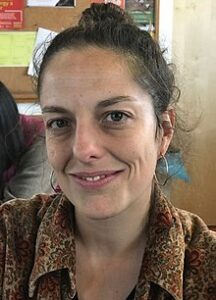The Adaptive Value Of Teenagers: How Peer Learning Contributes To Primate Success
No Comments yet
Brenna R. Hassett
03-01-2024 ~ Anthropological science is our species’ attempt to address our most fundamental questions about who we are and how we got here. It asks for evidence of the evolutionary path we have traveled to become the most successful primate on the planet; it seeks clues as to why Homo sapiens—and not our recent relatives—came to be the sole survivor of millions of years of hominid evolution. Many singular traits of our species and those of our immediate ancestors have been held up as prime movers in making us a world-dominating ape: controlling fire, walking upright, and making tools. However, more than anything, the evolution of big brains in the Homolineage around 2 million years ago is often identified as a turning point where we started to become the thinking animal. At some point in our evolutionary history, we became the ape that learns—and capacity for learning might just be the thing that let Homo sapiens become the species that we are today.
Of course, Homo sapiens is not the only animal that learns. It’s certainly not the only primate either—learning is a critical part of our closest relatives’ repertoire. Rather than relying on instinct, many primates pick up skills and information by learning them. In many species, learning is done through observation, which is as simple as it sounds: a baby will watch its mother to learn what foods are good to eat, or the young watch an experienced adult doing a particular task. As social animals, primates have a greater number of teachers available to them than other species, and who they learn from changes as they grow. Infant vervet monkeys, for instance, quickly learn to eat the foods their mothers like—but when they get older and move to a new group where that food isn’t liked, they will quickly learn to eat what their peers eat.
Primate life demands a host of skills that aren’t passed down through instinct alone—and aren’t always just survival skills. One of the best examples of such a skill is seen in the gloriously relaxed snow monkeys of the northern Japanese island of Hokkaido. The snow monkeys are a type of macaque, one of the most numerous (and interesting) monkey species, with a broad range of habitats around Asia and a host of different adaptations to live in each environment. The adaptation of the Hokkaido macaques, however, is something else again: they have taught themselves to bathe in the hot tub. In the 1950s tourism to the natural hot springs of Hokkaido led to the construction of hotels and onsen, traditional Japanese baths, in a group of macaques’ territory. One day a young macaque fell into an onsen while chasing an apple, and realized it was actually quite nice. Her peers watched and learned and then taught their children how to hot tub too, and so it became an established behavior among the group.
Peer learning is incredibly important for juvenile primates, precisely because of the complicated social groups they live in. As any teenager could tell you, it’s a matter of survival to fit in with your group, and, depending on your species, many young animals will move groups and have to learn entirely new ways of doing things. In some species, it will be the females that move groups, and they will carry with them any new skills from their home groups while also learning to adapt to new ones. In others, it will be males who may have a host of other challenges to overcome as they leave their birth groups. Gorillas, for instance, have a very rigid “harem” style social organization, with a handful of silverback males living with several females and their children. When the male children start to get older, they can either stay in their own groups and try to compete, or they can join special boy bands comprising those males that are too young (or too old) to challenge a silverback for a harem of their own. There, they can learn and practice the skills they need to build their own harem.
Peer learning is incredibly important to our species precisely because it is a way of transferring information beyond our own native social groups. Like the hot tubbing macaque or the young male gorillas, movement to a new group means that new ideas and skills are transported beyond their group of origin. Cultural transmission becomes possible, and ideas and adaptations are free to spread to wider groups. This means the number and scope of adaptations circulating is vastly increased—and with it, the evolutionary chances of the species. Humans have taken full advantage of this kind of learning by simply taking more time to do it. We take longer to move from puberty to full adulthood than any other species of primate. Indeed, when full adulthood actually occurs in our species is a matter of considerable debate.
When we look at the time in life when peer learning occurs, we see that it is when animals are on the cusp of adulthood—the ones that are mobile, changing groups, and playing around in an onsen—that contribute to this kind of wider learning. This is something that our species knows only too well. For anyone who has ever asked what the adaptive value of teenagers might be—or really, anyone during the long period between childhood and full adulthood that our species gives its young—the answer is simple. One of the most important adaptations we have made along the evolutionary path that has led to our species being the most prolific and successful primate on the planet is the time we take to learn how to be a better monkey.
By Brenna R. Hassett
Author Bio:
Brenna R. Hassett, PhD, is a biological anthropologist and archaeologist at the University of Central Lancashire and a scientific associate at the Natural History Museum, London. In addition to researching the effects of changing human lifestyles on the human skeleton and teeth in the past, she writes for a more general audience about evolution and archaeology, including the Times (UK) top 10 science book of 2016 Built on Bones: 15,000 Years of Urban Life and Death, and her most recent book, Growing Up Human: The Evolution of Childhood. She is also a co-founder of TrowelBlazers, an activist archive celebrating the achievements of women in the “digging” sciences.
Source: Human Bridges
Credit Line: This article was produced by Human Bridges.
You May Also Like
Comments
Leave a Reply








